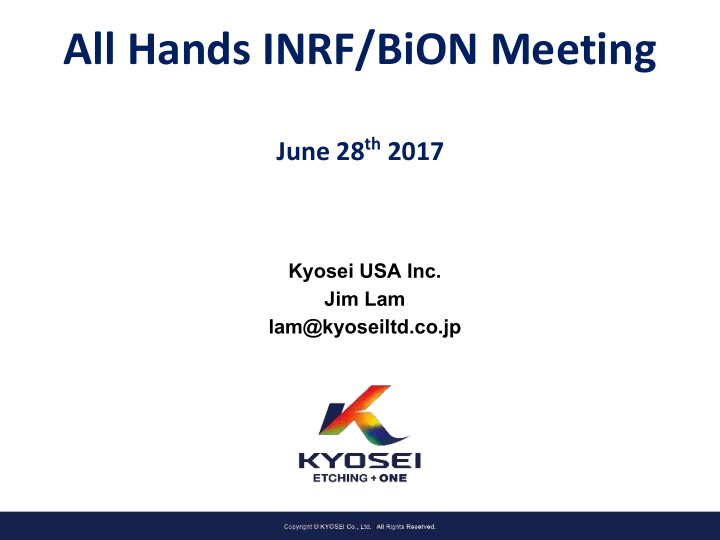



All Hands INRF/BiON Meeting June 28 th 2017 Kyosei USA Inc. Jim Lam lam@kyoseiltd.co.jp
Traditional Photoetching Overview Metal UV Exposure Apply photoresist Chemically dissolve metal with no photomask Align photomask Remove remaining photoresist 2
3D-Photoetching Process Raw Tube Clean Tube Photoresist Coating Exposure Develop Inner Photoresist Coating Etching Removal/Cleaning 3
3D-Photoetching Overview Kyosei original etching method Our 3D-photoetching method follows the same principles as traditional etching, this means we are able to have a quick response time for changes in designs as the only requirement is a photomask. There are a variety of applications, but the main focus at the moment are tubes. Kyosei has created many prototypes of stents and with the current manufacturing method being laser cutting, we hope 3D-photoetching will become an alternative option. Kyosei has also found success in 3D-photoetching magnesium, a bio-absorbable material. Because of magnesium’s low heat tolerance, it is a perfect match for photoetching technology. 4
3D-Photoetching Technical Information Cobalt Chrome & Nickel Material Stainless Steel & Magnesium Titanium Minimum Hole Size 0.10 mm 0.13 - 0.15 mm Minimum Thickness 0.005 mm 0.0065 – 0.0075 mm Maximum Thickness 0.10 mm 0.13 – 0.15 mm Minimum Distance 0.07 mm 0.09 – 0.11 mm Between Holes Minimum Pitch 0.17 mm 0.22 – 0.26 mm Distance Minimum Device 100 mm 100 mm Length (1 mm) (1 mm) Maximum Device 300 mm 300 mm Length (2000 mm) (2000 mm) Minimum Diameter 0.08 mm 0.08 mm Maximum Diameter 250 mm 250 mm 5
3D-Photoetching Advantages Advantages Description Enablers Stainless Steel, Material • Heatless procedure Mg & Ni-Ti *Developing Co-Cr • Crack-less compared Expected to be stronger Durability to heat affected than laser cut products zones in laser cutting • No dross Integrity High smoothness • No burr 80 micron diameter Downsizing • 3D-Etching tubes Expected to be more • Can process more Cost cost effective than laser than 1 tube at a time cutting 6
Kyosei & U.C. Irvine Partnership Kyosei works with researchers and local professionals on finding ways to apply our technology to current or future projects. UCI helps introduce Kyosei’s technology and capabilities to their network of business professionals and organizations. The partnership aims to be a symbiotic relationship that will allow for both organizations to grow and develop, while researching and innovating new methods of manufacturing precision components. 7
Recommend
More recommend